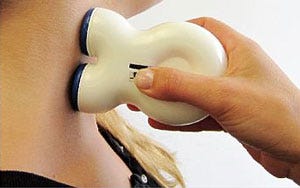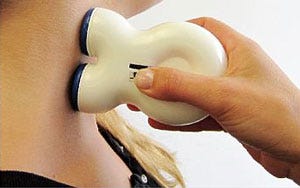January 23, 2013
J.P. Errico, the CEO and founder of the medical device firm ElectroCore, has an interesting background. He holds a degree in aeronautical engineering from MIT and and a mechanical/materials engineering degree from Duke University. At Duke, Errico also earned a law degree and he later became a patent attorney.
In an interview with MPMN, Errico shed light on the engineering process behind the development of ElectroCore's non-invasive technology, which stimulates the cervical branches of the vagus nerve to treat headaches as well as respiratory problems. The company's GammaCore device, which is on the market in Europe and Asia, can be used to treat chronic migraines and for cluster headaches. The company's AlphaCore device was designed for respiratory applications such as bronchoconstriction.
MPMN: Could you provide an overview of how ElectroCore's technology works?
 If you step back for a second, the vagus nerve is one of the cranial nerves. It is comprised of two fibers: A and C fibers. Most of the information that is carried along that nerve is carried in the afferent direction, meaning it is going up to the brain. It primarily acts as a sensor for the brain to know how the body is functioning. What we do is we intervene along that line at the cervical level and we depolarize the A fibers, enabling us to influence a certain response in the brain: causing the release of inhibitory neurotransmitters.
If you step back for a second, the vagus nerve is one of the cranial nerves. It is comprised of two fibers: A and C fibers. Most of the information that is carried along that nerve is carried in the afferent direction, meaning it is going up to the brain. It primarily acts as a sensor for the brain to know how the body is functioning. What we do is we intervene along that line at the cervical level and we depolarize the A fibers, enabling us to influence a certain response in the brain: causing the release of inhibitory neurotransmitters.
The treatment is patient administered. A patient would place the device up against their neck, turn it on and you modulate the level of the signal that they are experiencing. At the end of 90 seconds, they have received a single dose.
Vagus nerve stimulation has been around for 20 years, largely used to treat epilepsy. Cyberonics just announced that they have implanted their 100,000 patient with their device. The vast majority of that is for epilepsy but they do have an approval for depression. It has a lot of different potential applications, but Cyberonics has primarily gone after epilepsy and depression at this point.
What we found is that their device, which once implanted might be on for 30 seconds to 2 minutes and off for 5 minutes. Then it cycles back on, repeating that sequence forever. What we have found is that is a substantial overdose of vagal stimulation. The vagus nerve does not need to be stimulated that frequently to provide a significant benefit.
MPMN: What was the biggest engineering challenge the company faced when developing the technology and how did you overcome it?
|
ElectroCore's GammaCore (above) and AlphaCore (below) devices offer a non-invasive treatment option for headaches and respiratory problems respectively. |
It probably falls squarely in the area of making a noninvasive device that can be used in so many different ways. We had a moment of inspiration when we saw that vagus nerve stimulation could be used to treat bronchoconstriction. That is an area where we had a sort of flash of brilliance. Then we set about proving it using some off-the-shelf technology. But figuring out how to turn that technology into something that was noninvasive was a gigantic intellectual program that we were successful at. When I look back on it, I'll say that was such an important component of what we did and that we spent a long time working on it and making it right.
Discovering the fact that a single 90-second treatment could be effective in terms of acute and prophylactic aspects was something that was just a fact of nature. As a result of discovering it, we were able to make the noninvasive viable from a commercial perspective.
Figuring out how to make it a noninvasive device is really key--not just from my perspective but the perspective of the physicians that we are working with. That has been the thing that made them say: 'wow, how did they do that? That is really cool'
Several years ago, we call up the first neurologists [to discuss] using the device to treat headache. None of them were surprised that vagus nerve stimulation worked to treat headaches. In fact, they pointed us to places in the literature where it had been tried with implantable devices and it was very positive; most patients had significant success with it. They were surprised that it could be made noninvasive.
Cyberonics are the pioneers who came up with the idea of using vagus nerve as a venue for therapy. I have nothing but respect for what they've done. I think we got lucky in some things that we've found and it was somewhat serendipitous that we did. If you look at it from their perspective: they believed that the device needed to be on all of the time. They never would have tried to make something noninvasive. If you need to use the device every five minutes, then you are going to want to have it as an implant.
What we found is that you can change the need and that enabled us to be inventive in the area of making it noninvasive.
Brian Buntz is the editor-in-chief of MPMN. Follow him on Twitter at @brian_buntz.
About the Author(s)
You May Also Like



